As of desired publication time, 12:02 AM on November 29th, there are 51 days, 11 hours and 58 minutes before our Once and Future President, Donald John Trump, is restored to his rightful office.
Not that I’m counting, mind you.
What is it that feeds our battle, yet starves our victory?
Speaker Johnson
Pinging you on January 6 Tapes
Just a friendly reminder Speaker Johnson. You’re doing some good things–or at least trying in the case of the budget–but this is the most important thing out there still hanging. One initial block released with the promise of more…and?
We have American patriots being held without bail and without trial, and the tapes almost certainly contain exculpatory evidence. (And if they don’t, and we’re all just yelling in an echo chamber over here, we need to know that too. And there’s only one way to know.)
Either we have a weaponized, corrupt government or we have a lot of internet charlatans. Let’s expose whatever it is. (I’m betting it’s the corrupt weaponized government, but if I am wrong, I’d like to see proof.)
Justice Must Be Done.
The prior election must be acknowledged as fraudulent, and steps must be taken to prosecute the fraudsters and restore integrity to the system.
Nothing else matters at this point. Talking about trying again in 2022 or 2024 is hopeless otherwise. Which is not to say one must never talk about this, but rather that one must account for this in ones planning; if fixing the fraud is not part of the plan, you have no plan.
Small Government?
Many times conservatives (real and fake) speak of “small government” being the goal.
This sounds good, and mostly is good, but it misses the essential point. The important thing here isn’t the size, but rather the purpose, of government. We could have a cheap, small tyranny. After all our government spends most of its revenue on payments to individuals and foreign aid, neither of which is part of the tyrannical apparatus trying to keep us locked down and censored. What parts of the government would be necessary for a tyranny? It’d be a lot smaller than what we have now. We could shrink the government and nevertheless find it more tyrannical than it is today.
No, what we want is a limited government, limited not in size, but rather in scope. Limited, that is, in what it’s allowed to do. Under current circumstances, such a government would also be much smaller, but that’s a side effect. If we were in a World War II sort of war, an existential fight against nasty dictatorships on the brink of world conquest, that would be very expensive and would require a gargantuan government, but that would be what the government should be doing. That would be a large, but still limited government, since it’d be working to protect our rights.
World War II would have been the wrong time to squawk about “small government,” but it wasn’t (and never is) a bad time to demand limited government. Today would be a better time to ask for a small government–at least the job it should be doing is small today–but it misses the essential point; we want government to not do certain things. Many of those things we don’t want it doing are expensive but many of them are quite eminently doable by a smaller government than the one we have today. Small, but still exceeding proper limits.
So be careful what you ask for. You might get it and find you asked for the wrong thing.
Political Science In Summation
It’s really just a matter of people who can’t be happy unless they control others…versus those who want to be left alone. The oldest conflict within mankind. Government is necessary, but government attracts the assholes (a highly technical term for the control freaks).
His Truth?
Again we saw an instance of “It might be true for Billy, but it’s not true for Bob” logic this week.
I hear this often, and it’s usually harmless. As when it’s describing differing circumstances, not different facts. “Housing is unaffordable” can be true for one person, but not for another who makes ten times as much.
But sometimes the speaker means it literally. Something like 2+2=4 is asserted to be true for Billy but not for Bob. (And when it’s literal, it’s usually Bob saying it.) And in that sense, it’s nonsense, dangerous nonsense. There is ONE reality, and it exists independent of our desires and our perceptions. It would go on existing if we weren’t here. We exist in it. It does not exist in our heads. It’s not a personal construct, and it isn’t a social construct. If there were no society, reality would continue to be what it is, it wouldn’t vanish…which it would have to do, if it were a social construct.
Now what can change from person to person is the perception of reality. We see that all the time. And people will, of course, act on those perceptions. They will vote for Trump (or try to) if their perception is close to mine, and vote against Trump (and certainly succeed at doing so) if their perception is distant from mine (and therefore, if I do say so, wrong). I have heard people say “perception is reality” and usually, that’s what they’re trying to say–your perception of reality is, as far as you know, an accurate representation of reality, or you’d change it.
But I really wish they’d say it differently. And sometimes, to get back to Billy and Bob, the person who says they have different truths is really saying they have different perceptions of reality–different worldviews. I can’t argue with the latter. But I sure wish they’d say it better. That way I’d know that someone who blabbers about two different truths is delusional and not worth my time, at least not until he passes kindergarten-level metaphysics on his umpteenth attempt.
Lawyer Appeasement Section
OK now for the fine print.
This is the WQTH Daily Thread. You know the drill. There’s no Poltical correctness, but civility is a requirement. There are Important Guidelines, here, with an addendum on 20191110.
We have a new board – called The U Tree – where people can take each other to the woodshed without fear of censorship or moderation.
And remember Wheatie’s Rules:
1. No food fights
2. No running with scissors.
3. If you bring snacks, bring enough for everyone.
4. Zeroth rule of gun safety: Don’t let the government get your guns.
5. Rule one of gun safety: The gun is always loaded.
5a. If you actually want the gun to be loaded, like because you’re checking out a bump in the night, then it’s empty.
6. Rule two of gun safety: Never point the gun at anything you’re not willing to destroy.
7. Rule three: Keep your finger off the trigger until ready to fire.
8. Rule the fourth: Be sure of your target and what is behind it.
(Hmm a few extras seem to have crept in.)
(Paper) Spot Prices
Kitco “Ask” prices. Last week:
Gold $2,716.90
Silver $31.41
Platinum $973.00
Palladium $1,034.00
Rhodium $4,950.00
FRNSI* 130.430+
Gold:Silver 86.498-
This week, 3PM Mountain Time, markets have closed for the weekend. (This time, apparently, markets closed at 12:45, not 3PM.)
Gold $2,650.10
Silver $30.69
Platinum $954.00
Palladium $1002.00
Rhodium $4,850.00
FRNSI* 127.199-
Gold:Silver 86.351-
Gold took a ninety dollar thumping on Monday, seemed to be going nowhere the rest of the week, but has recovered a little bit on Friday. The same is pretty much true of the other precious metals, though one will note rhodium actually dropped a bit. The gold:silver ratio still sucks (if you’re a silver fan).
*The SteveInCO Federal Reserve Note Suckage Index (FRNSI) is a measure of how much the dollar has inflated. It’s the ratio of the current price of gold, to the number of dollars an ounce of fine gold made up when the dollar was defined as 25.8 grains of 0.900 gold. That worked out to an ounce being $20.67+71/387 of a cent. (Note gold wasn’t worth this much back then, thus much gold was $20.67 71/387ths. It’s a subtle distinction. One ounce of gold wasn’t worth $20.67 back then, it was $20.67.) Once this ratio is computed, 1 is subtracted from it so that the number is zero when the dollar is at its proper value, indicating zero suckage.
Flat Earth Cowards
Just remember that David Weiss, Eric Dubay, Mark Sargent, Nathan Oakley, Dean Odle, and Volker Meyer, all Flat Earth proponents on the internet, are intellectual cowards at best, and knowing fraudsters (politespeak for motherfucking liars) at worst, and I am in this case inclined to believe the worst.
After years of maintaining that the Sun does indeed set in Antarctica during the southern summer, but then claiming people aren’t allowed to go look, they’ve turned down the opportunity to go look. Worse, many of them condemn Jeranism, Whitsit Gets It, and Lisbeth Acosta for going.
Any reasonable person looking at this behavior should see the hallmarks of a fraudster. The fraudster wants you to believe what he says unconditionally. The fraudster wants you to 1) ignore the lack of evidence for his position and 2) the actual evidence against his position. This is a system for protecting lies.
Would someone condemn people for going and looking, if they sincerely thought their position was true?
These people are pushing bullshit and they know they are pushing bullshit. These people are lying turds.
By contrast, eight of the globers who spend time debunking flerfers are going, one is paying for himself, one is getting the free ride offered as part of TFE, the other six are crowd funded. Globers also crowdfunded Lisbeth to go when the anonymous donor who funded a drawing for the flerfers turned out to himself be a flerfer fraud. Globers crowd funding her, not flerfers. All of the globers (and many who are not going, such as Professor Dave Explains) have vowed to remove their anti-flat earth content and post a statement that the earth is flat, if the sun actually sets for those at the Final Experiment.
Who is acting confident in their position…and who is acting like they are afraid this whole thing will make it obvious they are simply worthless shitbag liars?
On The Fringes? The Trans-Neptunian Worlds
There are nine objects that are likely “dwarf planets” (i.e. objects too small to be “real” planets, but which are nevertheless rounded by their own gravity and orbit the Sun directly). It’s difficult to confirm the roundness of many of these as all we can see of them is a fuzzy blob, even with the Hubble Space Telescope.
Here they are:
| Name Minor Planet Number | min, max distances, (mean) (in AUs) | Eccentricity (0=circular, 1=parabola) | Inclination to ecliptic (degrees) | Period (years) | Year Discovered | Precovery Date |
| Ceres 1 | 2.55- 2.98 (2.77) | 0.0785 | 10.6 | 4.60 | 1801 | – |
| Pluto 134340 | 29.658- 49.305 (39.482) | 0.2488 | 17.16 | 247.94 | 1930 | 1909 |
| Quaoar 50000 | 41.900- 45-488 (43.694) | 0.04106 | 7.9895 | 288.83 | 2002 | 1954 |
| Sedna 90377 | 76.19- 937 (506) | 0.8496 | 11.9307 | 11,390 | 2003 | 1990 |
| Orcus 90482 | 30.281- 48.067 (39.174) | 0.22701 | 20.592 | 245.19 | 2004 | 1951 |
| Haumea 136108 | 34.647- 51.585 (43.116) | 0.19642 | 28.2137 | 283.12 | 2003 | 1955 |
| Eris 136199 | 38.271- 97.457 (67.864) | 0.43607 | 44.040 | 559.07 | 2005 | 1954 |
| MakeMake 136472 | 38.104- 52.786 (45.430) | 0.16126 | 28.9835 | 306.21 | 2005 | 1955 |
| Gonggong 225088 | 33.781- 101.190 (67.485) | 0.49943 | 30.6273 | 554.37 | 2007 | 1985 |
A word of explanation: The “precovery” date is the oldest image found of the object, when they go back looking to see if anyone ever accidentally photographed it. This seems like a bit of trivia, but those images can be extremely useful for determining the orbit of the object (not just the semi major axis, inclination and eccentricity but also the longitude of the ascending node, argument of perihelion and time of perihelion–those three orient the orbit (along with the inclination) and put the object at a certain spot in the orbit). This is why astronomers never throw away an astrophotograph; it may be beneficial decades later.
It should be noted that the full list of possible dwarf planets is 28 objects long, based on estimated diameters, though some have no names (just minor planet numbers). For the sheer sake of self-preservation, one should probably hope that 229762 Gǃkúnǁʼhòmdímà does not make the list, as !Kung words are notoriously hard to pronounce. (No, I am not making that up.)
By the opposite token, only Ceres and Pluto are absolutely solidly confirmed to be dwarf planets; it pretty much takes a spacecraft mission to confirm it.
Ceres is an outlier, obviously, because it’s the only object in the table that isn’t a trans-Neptunian object. I’ve covered asteroids already, so from this point forward I am going to ignore the world Ceres. (Never was much into baseball anyway.) Aside from Ceres the other oddball is Sedna, with a huge eccentricity and a huge orbit; it makes all of the others pale in comparison.
What would a well behaved full-blown classical planet look like in that table? It would have a low eccentricity and a low inclination. Quaoar actually behaves more like a planet than any of the others in the table (even including Ceres).
Here is another diagram, showing relative sizes, shapes, colors and brightnesses of these and some other objects. The color is of course an average color. In some cases there’s uncertainty as to size (as with Sedna), in which case a half-arc is shown at the maximum diameter. This one might reward a right-click-and-open-in-new-tab.
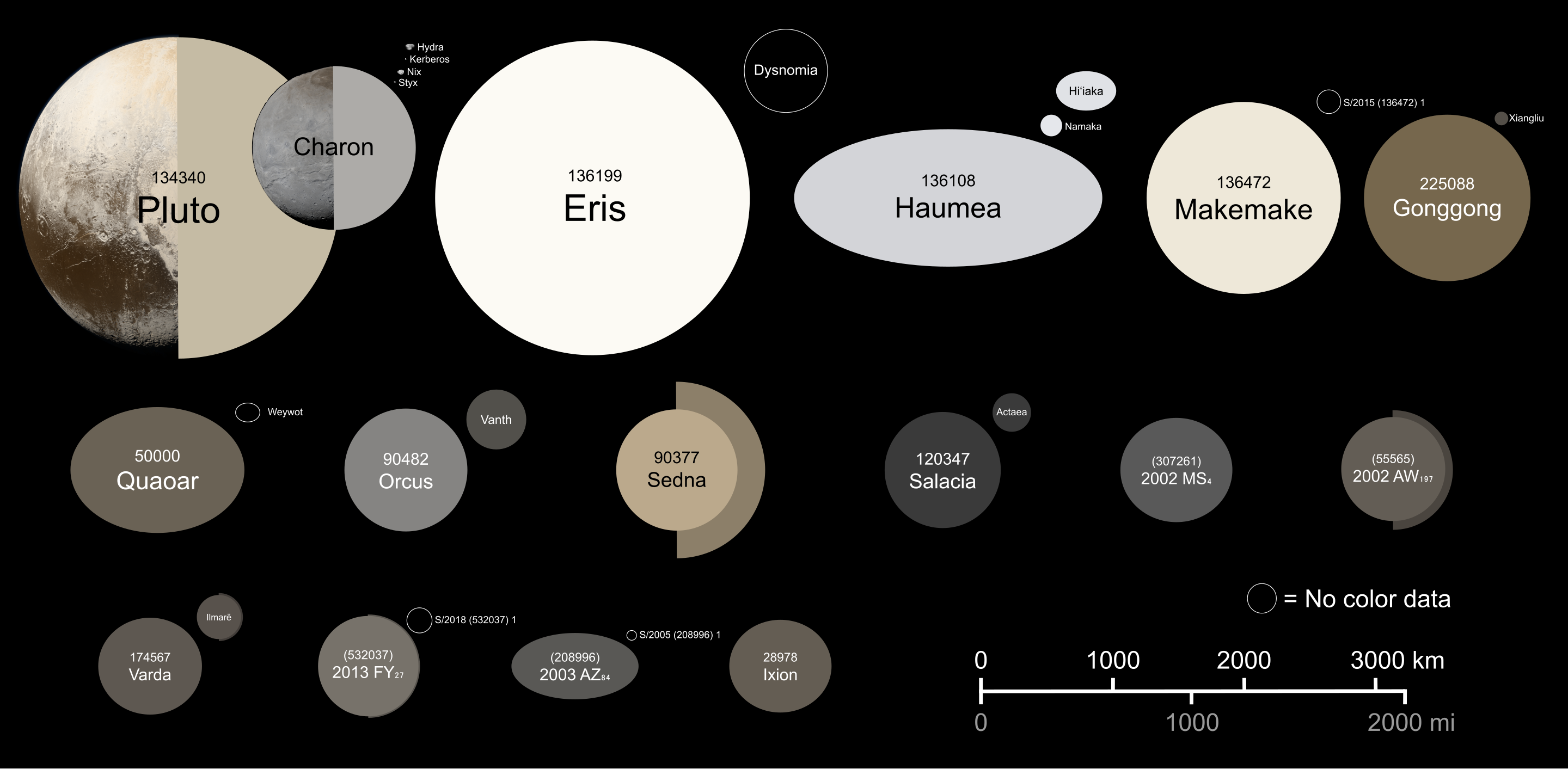
So now let’s take a look at these in more detail; I’m going to save Sedna and Pluto for last (and not bother at all with Ceres).
Quaoar
Quaoar (pronounced kwah-wahr, though more strictly speaking it should be “kwa’uwar” with the ‘ representing a glottal stop as you hear in the Hawaiian pronunciation of Hawai’i) is named after a deity of the Tongva people, and for me at least that answers nothing until I go look up “Tongva people.” It turns out they were a tribe in what is now the Los Angeles basin. (They also call themselves the Kizh.) Their language is distantly related to Aztec.
Quaoar was discovered 4 June 2002 by Chadwick A. Trujillo and Michael E. Brown at the Palomar Observatory (they were not using the big 200 incher but one of the smaller (but still big) instruments, the Samuel Oschin telescope. They were running a survey looking for Kuiper belt objects (little did they know…). Once it was determined that Quaoar was not in a resonance with Neptune (making it a qubewano-class TNO), the naming convention dictated it be named after a creation deity; Brown and Trujillo consulted with some present-day Tongvas to be sure it was an appropriate name.
Quaoar is an elongated ellipsoidal shape averaging 1090 km across, making it less than half the size of Pluto (2,376.6 km). (We know it’s not perfectly spherical because its brightness varies over a span of 17.68 hours–which we infer is its day. This could just be brightness differences, like with Iapetus, but we’ve also watched Quaoar cross in front of stars and timing the length of the blackouts leads to different estimates of the diameter.) Quaoar is also a very dark object reflecting only 12% of the light it gets from the Sun (which ain’t much to begin with!) It’s somewhat reddish, like 20000 Varuna and 28978 Ixion (both objects that are on the “long list” of possible dwarf planets).
So if it’s not really round, what’s the deal with it being considered a dwarf planet? Normally any rocky body over 900km or so, or any icy body between 200-400 km across should go round. If it’s slowly rotating it should be a bit oblate (wider at the equator than through the poles). A faster rotation should resemble Haumea’s case (see below). So how can Quaoar not be round? It’s absolutely big enough. It’s possible that Quaoar used to rotate more quickly, froze into shape and then Weymot slowed its rotation down due to tidal effects. (Saturn’s moon Iapetus has a similar situation going on but is not as extreme.)
Here are the discovery images put together as a GIF. It’s easy to spot when there’s an arrow, isn’t it?

And now (drumroll) our best image, from the Hubble space telescope:
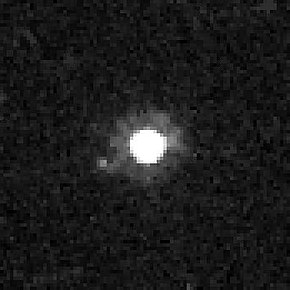
And yes, Quaoar has a moon, Weywot, discovered by Brown in February 2007; Weywot is the son of Quaoar in Tongva mythology. Weywot is about 200 km across (though some places in Wikipoo show it as smaller), which makes it too small to be rounded (the smallest rounded object known is Mimas (Saturn’s “Death Star” moon), at 396.4 km; there is at least one non-rounded objects that are larger: Neptune’s moon Proteus). Quaoar also has a ring.
Here are a couple more diagrams, the first being a picture of Quaoar’s orbit (in cyan and blue) compared to Neptune (white) and Pluto (red). The two spheres are not only about the right sizes, comparatively speaking (but not compared to the size of the orbits!), but they are correctly colored (an average color) and even the brightness (albedo) is correct.
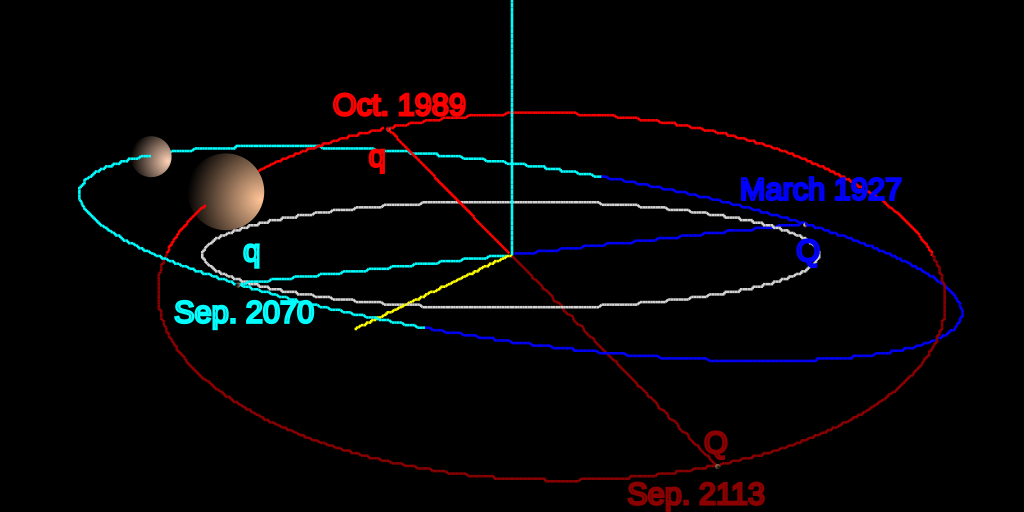
And another, an “overhead” view with Quaoar in yellow, Pluto in magenta/pink, Neptune in blue, and a few other TNOs in a drab green.
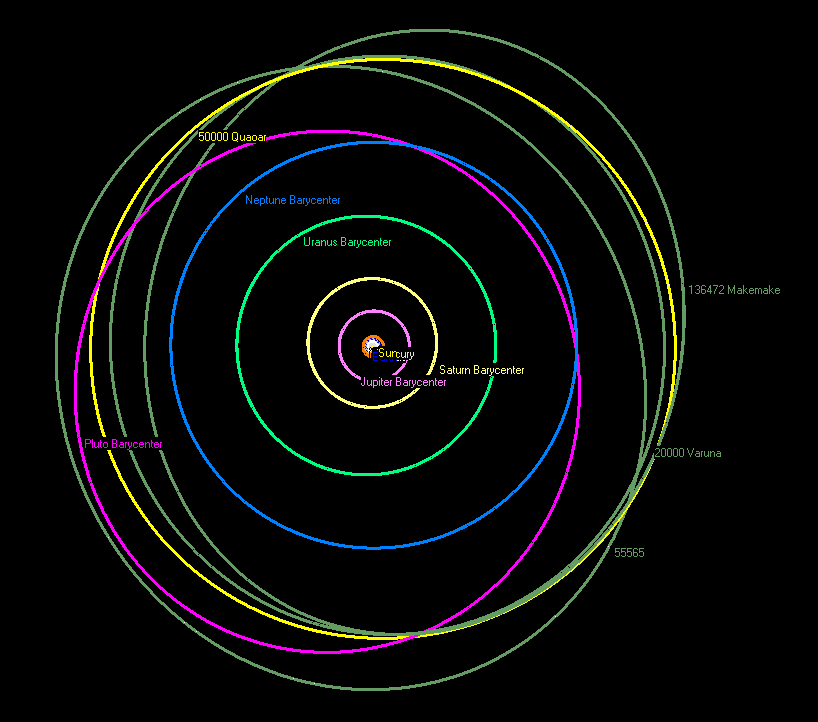
On the whole, we know next to nothing about this one…and that’s pretty much going to be true of most of the others. They’re just too doggone far away.
Orcus
Orcus is estimated to be anywhere from 870-960 km across, thus about the size of Ceres. It’s fairly bright, neutral in color and largely made of water ice; apparently the ice is mostly crystalline so maybe sometime in the past there was cryovolcanism (i.e., water volcanoes).
Orcus was discovered by Michael Brown, Chad Trujillo and David Rabinowitz on 17 February 2004 (note that two of these astronomers also discovered Quaoar). In this case, Orcus got named after one of the Roman gods of the underworld, because it’s a plutino.
What is a plutino? Plutinos are objects that, like Pluto, are in a 2:3 orbital resonance with Neptune, orbiting twice in the time it takes Neptune to orbit three times. (Note in the chart above it has nearly the same year, and mean orbital distance, as Pluto.) But Orcus tends to be furthest away from the Sun when Pluto is closest, and vice versa.
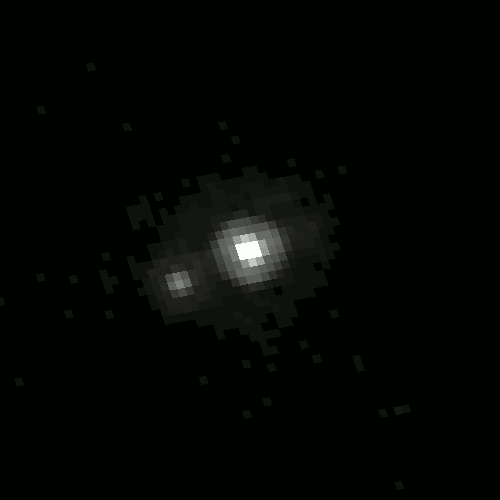
Here we see a Hubble Space telescope image of Orcus, and its moon Vanth. Vanth is estimated to be 475 km across by some, which is easily large enough to end up in that “Medium Small” 250-500km size bucket with Mimas, Hyperion, Proteus and Nereid, but other estimates put it below that 400 km line yet still in that bucket. Considering it’s likely frozen solid, and how rigid ice is at those temperatures, it’s not expected to be a round moon. (Note that I made a point to talk about any moon in that size bucket, and above, as I went through the 8 big planets.)
Vanth was named after an Etruscan deity, a “psychopomp” who guides the deceased to the underworld.
It is, however, big enough that the center of gravity of the Orcus-Vanth system is actually outside of Orcus, making it a double object. Vanth orbits Orcus in 9.54 days, and appears to rotate in the same amount of time. The rotation of Orcus, on the other hand, has been harder to nail down, so we don’t know if both bodies are tidally locked or just Vanth.
All in all, Orcus is often thought of as an “anti Pluto” since it’s phased the opposite of Pluto and has a (proportionately) large moon like Pluto. It’s even more striking when you see the visual of the orbit (Neptune’s orbit in white, Pluto’s orbit in red, Orcus in cyan and blue–note the color changes when the object crosses the ecliptic, and note the spheres are to scale with each other, the correct colors and albedos, again):
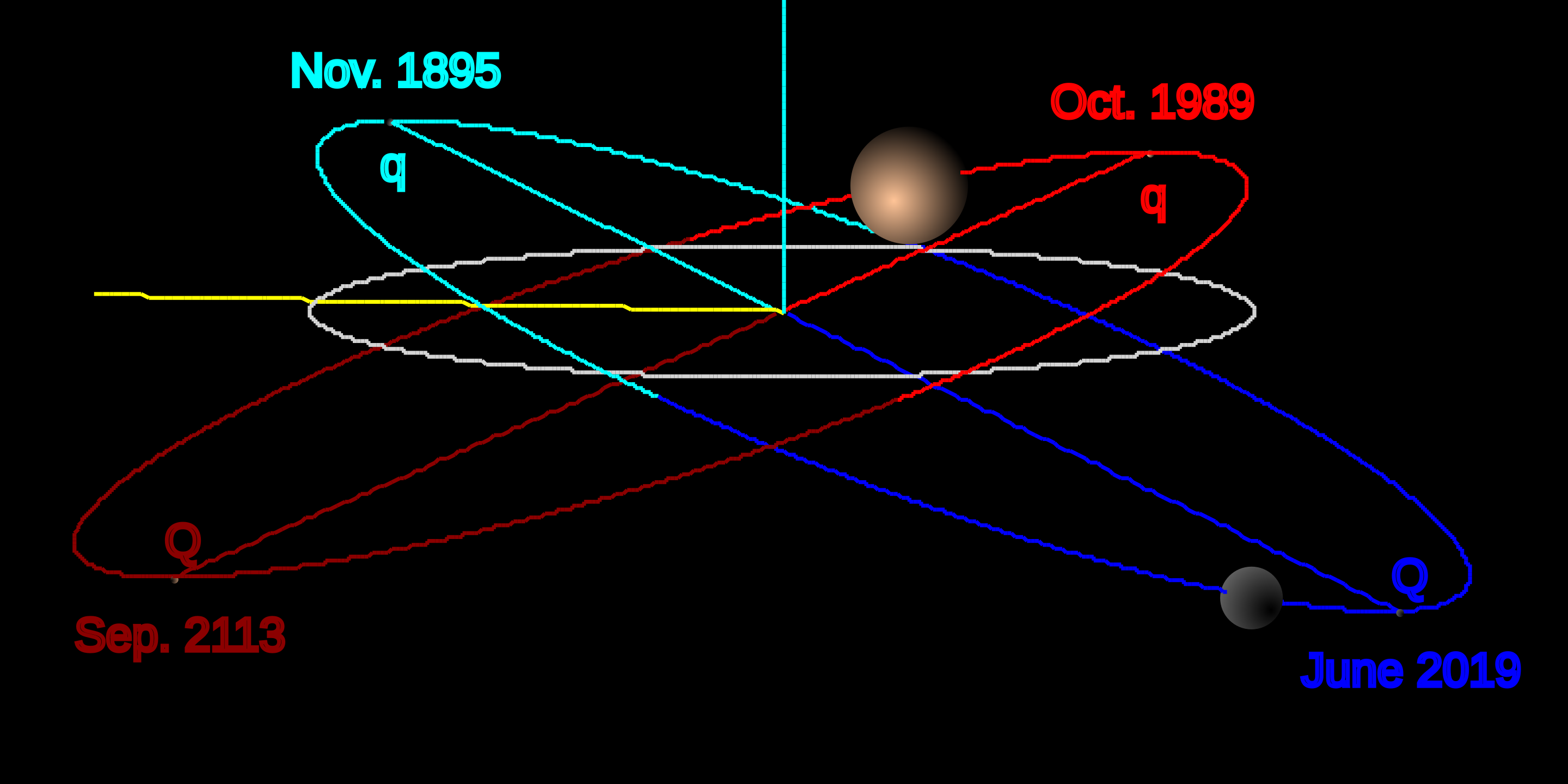
Haumea
Haumea is named after the Hawai’ian goddess of childbirth. It was discovered by Mike Brown at Caltech, but announced by a team headed by Jose Luis Ortiz Moreno at the Sierra Nevada Observatory…not our Sierra Nevadas, but rather the ones in Spain. There’s controversy over who should get the credit for this one. It’s the third largest TNO after Pluto and Eris. Here’s a picture, again from the Hubble Space Telescope:
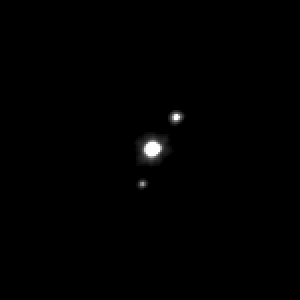
This one’s a bit odd. Based on watching it fluctuate in brightness, it’s a very elongated triaxial ellipsoid, meaning it has a long axis, a medium axis at right angles to that, and a short axis at right angles to the other two. Here’s an artist’s rendering of Haumea:
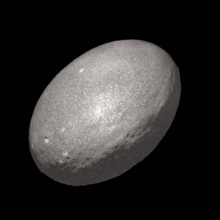
But this is actually the shape one would expect of a rapidly rotating object under hydrostatic equilibrium; Haumea rotates in about four hours.
So how long are the axes? Haumea is roughly 2100 by 1680 x 1074 kilometers. Or perhaps 2322 x 1704 x 1026. Depending on whose numbers you believe. Either way, it’s a sizeable object.
Haumea has moons, as you likely noticed…not just one but two of them known so far. Hi’iaka (upper right in the picture) is a medium-small moon about 310 km across, in that same “bucket” as Mimas, but probably not rounded. Namaka (lower left) is roughly 170 km across. They are named after two daughters of Haumea, the patron goddesses of the Big Island of Hawai’i, and the sea, respectively.
(That brings us, by the way, to the end of the list of medium-small moons: Mimas, Hyperion, Miranda, Proteus, Nereid, Vanth, and Hi’iaka… or does it? It turns out ttwo additional objects on the long list of possible dwarf planets, Salacia and Varda, also have moons in this size bucket. And there’s an almost perfectly-matched double body, Lempo (at 272 km) and Hiisi, with the best estimate for Hiisi being 251km (just squeaking by). If there’s one thing about TNOs, it’s that they tend to have comparatively large moons!)
Haumea is as bright as snow, with an albedo of 0.73…meaning that 73 percent of the light that hits it is reflected back. It seems to have crystalline ice on it, which is puzzling, because crystalline ice should only form above 100 K, and Haumea is at 50K, and only amorphous ice should form at that temperature. Furthermore once it forms, cosmic rays plus what’s left of the solar wind out there should degrade it to amorphous ice in about 10 million years. On top of that, old surfaces out there end up covered in tholins (“star tar”), making them appear red. So it seems that Haumea’s surface is new, but we don’t know how that could have happened. (I could spitball it, but that would be worth less than you paid for this article.)
Haumea appears to have a ring, discovered as it passed in front of a star.
Haumea turns out to be the largest member of a family of objects that have similar orbits and it appears they may all be remnants of a larger body that broke apart due to a collision. But it appears to have happened at least a billion years ago based on orbital dynamics considerations, so that won’t explain the white, crystalline ice surface of Haumea.
The New Horizons probe that went to Pluto actually took some pictures of Haumea on three different occasions…from quite a distance however. The 2007 shots were from 49 AUs away, others were in 2017 at 59 AU and in 2023 at 63 AU. Still, being able to compare the “side view” from what we see on Earth has been helpful.
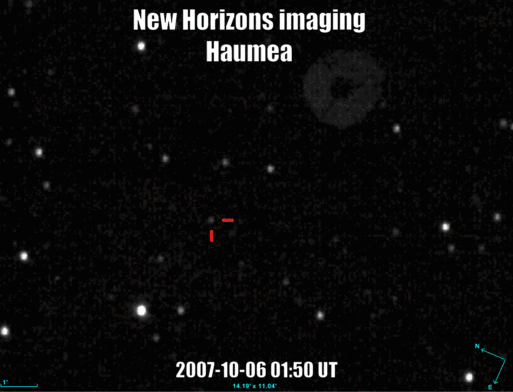
Haumea’s orbit turns out to resemble Makemake’s (see below). As a bonus Quaoar is also shown:
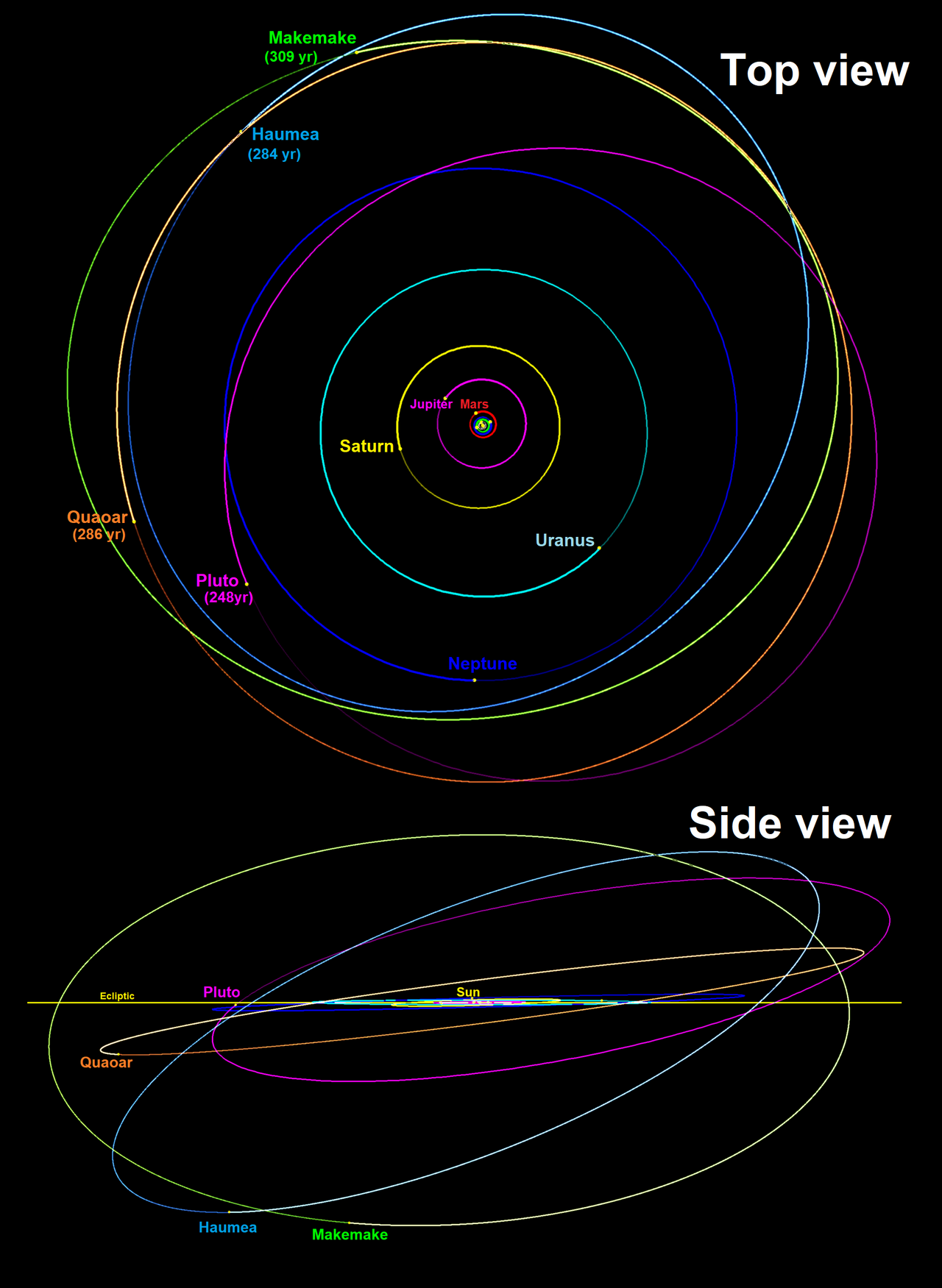
Eris
We talked about Eris a lot last time. With a diameter of 2326 km it’s a smidge smaller than Pluto, but it’s denser (more rocks, less ice) but is considerably more massive than Pluto, 27% more in fact. As pointed out last time, if Pluto is a planet, Eris is too.
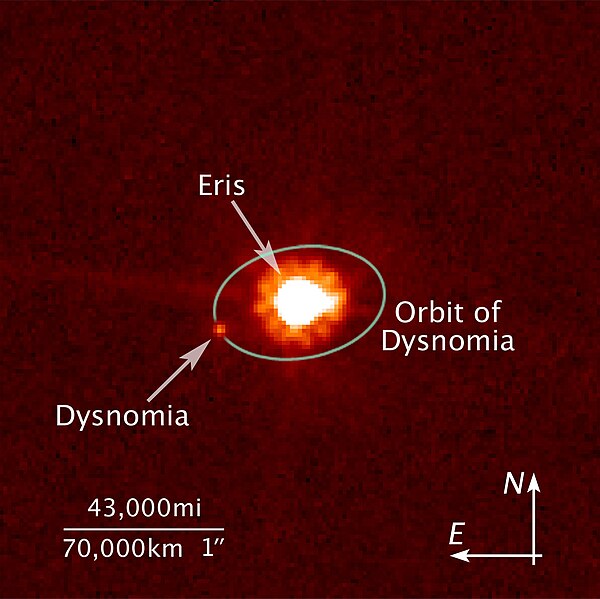
Here are Eris and Dysnomia photographed in 2006, and we’re lucky to have this, because at the moment Eris is 96.3 AUs from the Sun.
Here’s the same sort of orbital diagram I’ve showed for the others…but note in this one Neptune’s orbit is quite small.
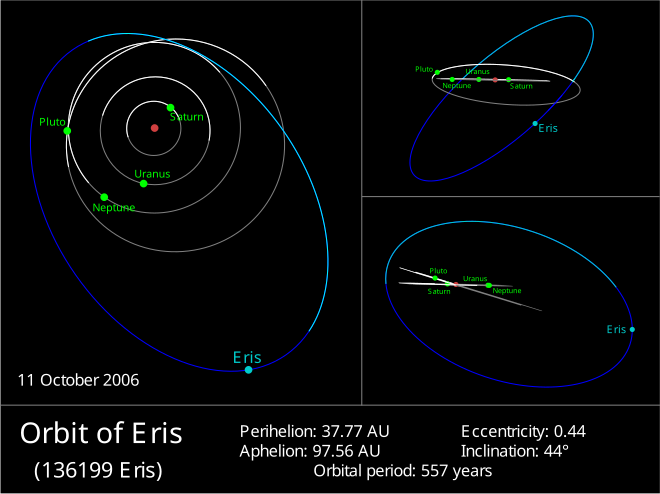
MakeMake
Makemake (MAH-ke-MAH-ke) is comparable in size to Saturn’s moon Iapetus, or 60% the diameter of Pluto. From what little of it we see, it may actually have geothermal activity, even though it’s one of the coldest bodies in the solar system at 40K. (When you see the words “possibly nitrogen ices” in a wikipoo article, you know the place is colder than Hitlary Klinton’s lap.) It’s named after a creator god in the Rapa Nui mythology of Easter Island. Again, Michael Brown is on the list of discoverers. And again we have a fuzzy image from Hubble Space Telescope.

And yet again, we have a moon, one that hasn’t been named yet.
Makemake is bright enough–brighter than any TNO other than Pluto–that perhaps it should have been discovered much sooner (maybe even by Clyde Tombaugh). There are even claims that Tombaugh in fact should have seen it, but it was buried right in the Milky Way and with all those stars around it, it would have been hard to spot. However, it hasn’t been spotted in any of his photographs, so it’s not that he photographed it and didn’t notice. It turns out the earliest precovery date is 1955 and Tombaugh stopped looking for additional objects in 1943.
Here’s another one of those graphics of the orbits, as usual the ecliptic in white, Pluto in red. Haumea is in green and MakeMake is on the blue line. The closest and farthest approaches to the sun (the perihelia and aphelia are given. The spheres are correctly sized, the correct colors and the correct albedos.
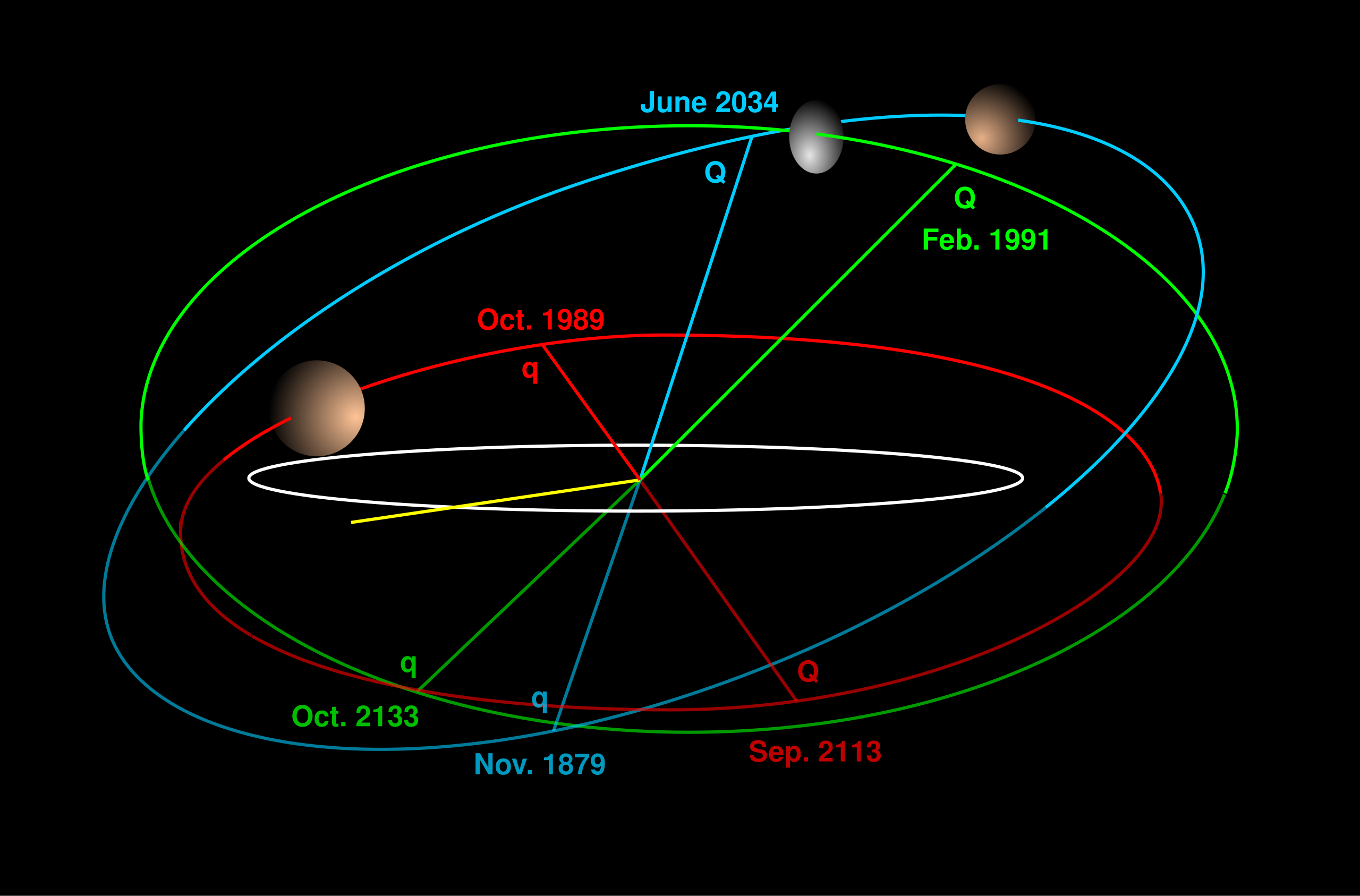
Gonggong
Discovered by Megan Schwamb, Michael Brown and David Rabinowitz on 17 July 2007, again as part of that Palomar Distant Solar System Survey. Megan Schwamb actually was the first to spot it with the blinking technique that Tombaugh used to discover Pluto. Gonggong is a water god in Chinese mythology, usually depicted as having a copper and iron human head on a serpent’s body. Gonggong is often accompanied by Xiangliu, his minister, a nine-headed poisonous snake. Both are associated with flooding catastrophes.
But enough about the Deep State.
Gonggong is 1230 km across (give or take 50 km), about half the width of Pluto, and a fairly dark body. Here is another Hubble Space telescope image:
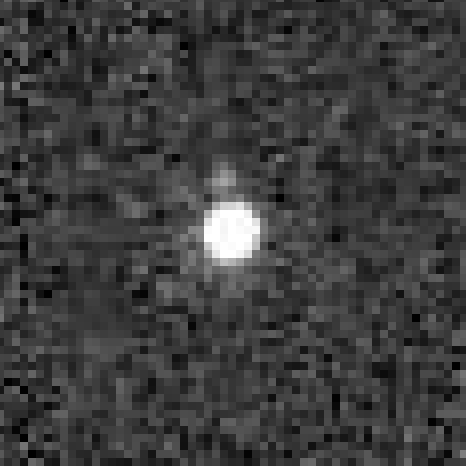
And yes, there’s a moon, named Xiangliu, of course.
Gonggong is very red, so almost certainly covered in tholins. There is some water ice, so maybe there was some cryovulcanism in the distant past.
It’s a lot like Eris in having a large orbit, as seen in this polar view (view from above) in which both it and Eris are shown:
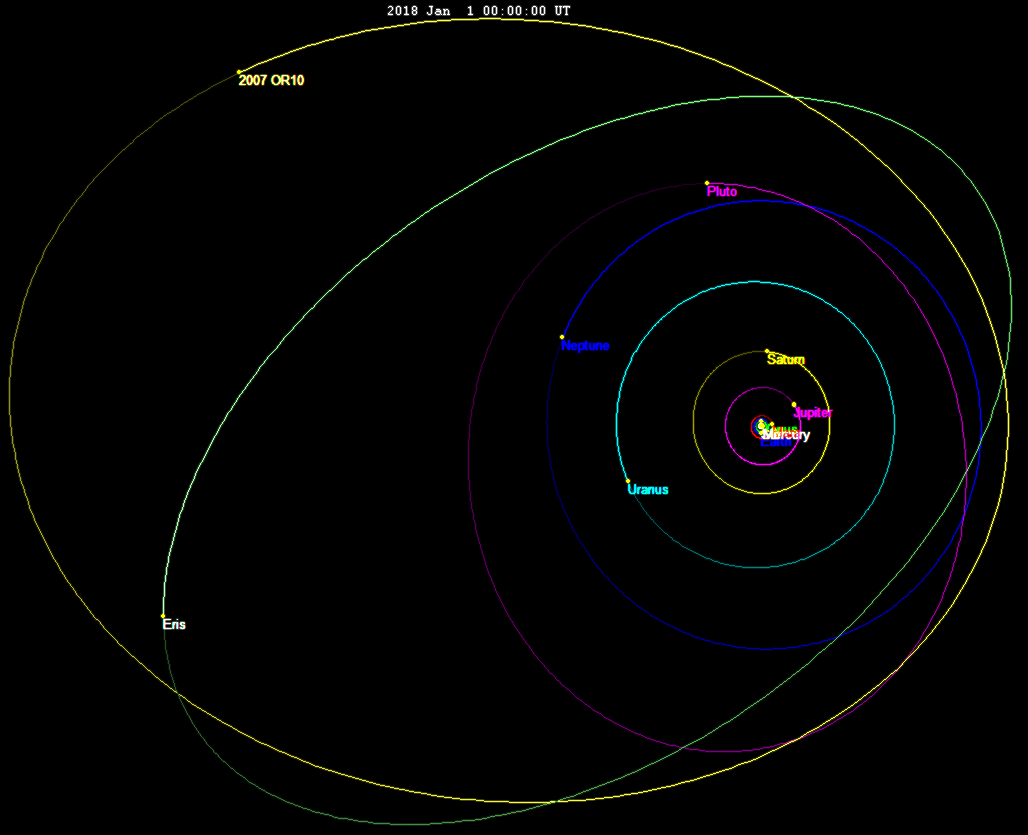
And the same thing, seen from the side:
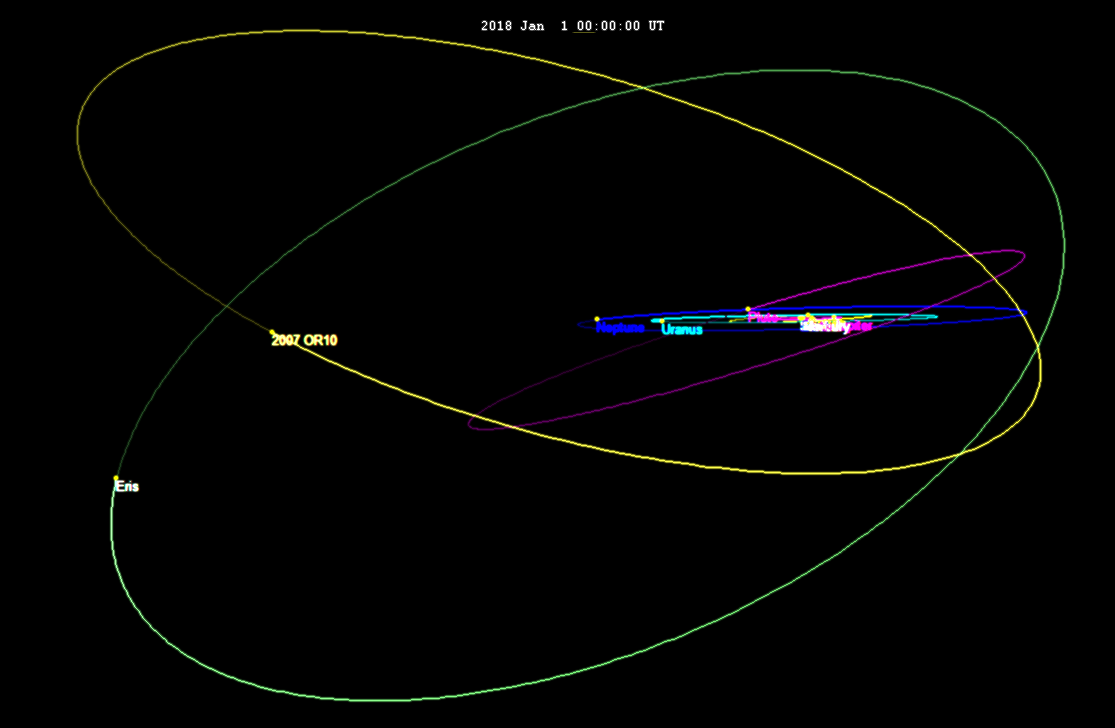
Gonggong and Eris seem to have similarly-extreme orbits (but not nearly the same orbit). Right now Gonggong is 88 AUs distant. Based on color and brightness it’s likely made of the same stuff as Quaoar.
Sedna
And now to go back to Sedna. Sedna is just…different from the rest. It’s red, it’s far, far away, and it’s going to get a lot farther away, eventually. It’s also the only one of these nine with no known moon. It’s very roughly 1000 km across. And because it has no moon whose orbit we can measure and time, we have only the vaguest notion of its mass. And now for a smashingly spectacular picture from Hubble Space Telescope:

Although I was flippant when I said that, if you think about it, it’s a huge acheivement to be able to take even this picture. Sedna is presently 83.55 AUs or 12.5 billion kilometers away. Right now Eris and Gonggong are further away, but that won’t remain true forever, since Sedna’s aphelion is 937 AU, not only busting into triple digits for the first time, but nearly reaching four digits.
Sedna is not the furthest though. There is a smaller object with and even more extreme orbit, 541132 Leleakohonua, perihelion 65.16 AU and aphelion…are you sitting down? of 2106 AU, with an orbital period of 35,760 years. However, this object is maybe 110 km across and in no way a dwarf planet. Right now it’s about 78 AUs out, getting closer to perihelion in 2078. (As a bonus the eccentricity actually busts the 0.900 mark at 0.93997.)
Neither of these objects would ever have been found if they didn’t happen to be at the near part of their orbits. Given that objects like this spend a lot less time near the sun than they do further away, there are probably a lot of them out there, simply too far away for us to detect.
Objects like this are so extreme, there’s now a new class of objects, “Sednoids” including these two plus one other (a bit less extreme than Sedna). Some have suggested that they’re really members of the inner Oort Cloud. (I haven’t talked about the Oort cloud…yet.)
There is also speculation that these crazy orbits are caused by encounters with a full planet out there somewhere, perhaps 400AU out. The fact that a lot of aphelions seem to be in very roughly the same place lends credence to this. Here are the three “Sednoid” objects (2015 TG387 is Leleakohonua’s provisional number):
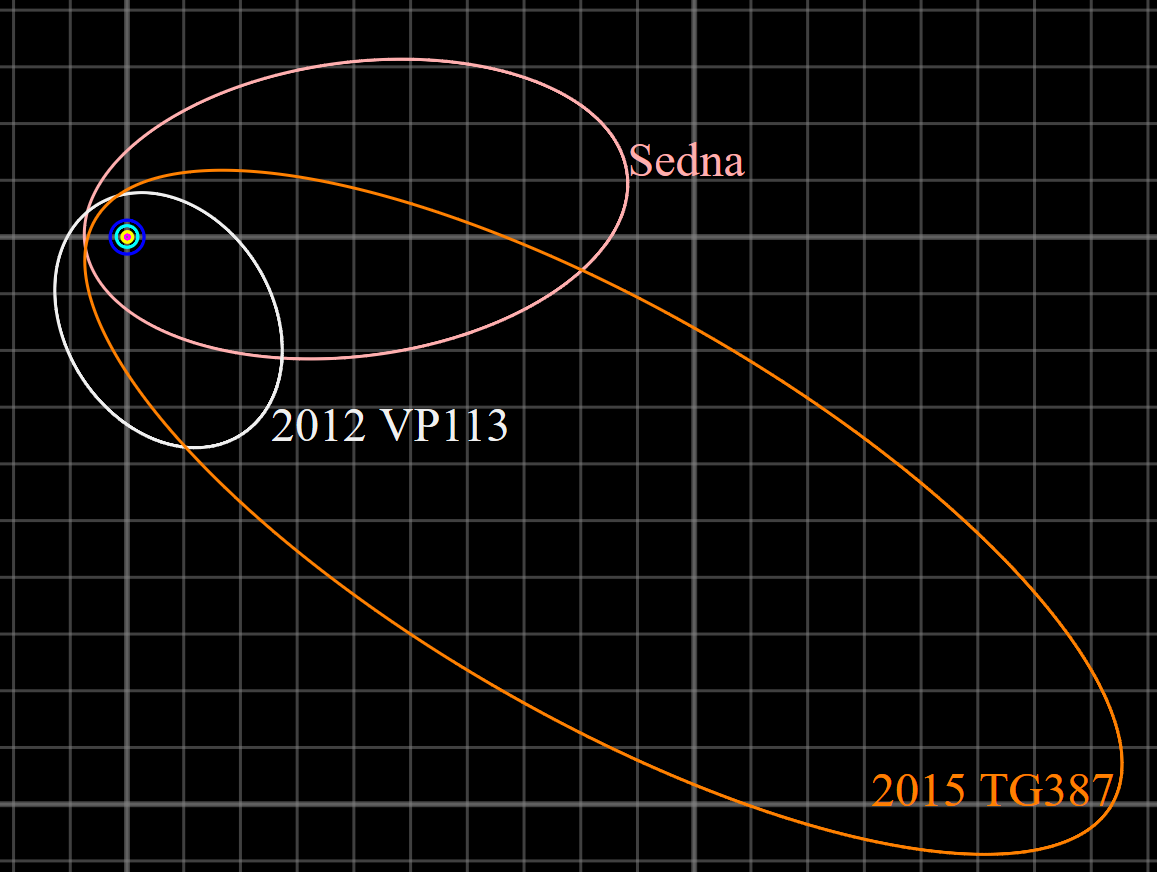
Pluto (Finally)
An Ode to New Horizons
Until the Hubble space telescope, a typical photo of Pluto showed a bunch of white dots on a black background, and an arrow pointing to one of them. Pluto was only distinguishable from stars by its motion, which took days to become obvious.
Then Hubble Space Telescope took a look in 2003, and what it gave us, was used to make this animation, as Pluto did a full rotation in 6.4 days…retrograde, apparently:
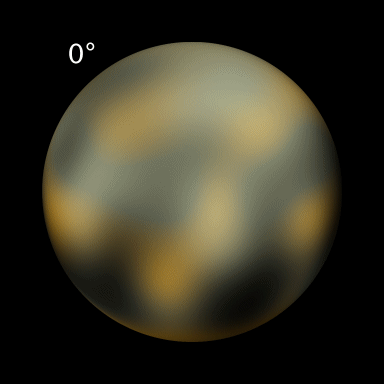
Then suddenly in 2015…you could buy a fricking globe of Pluto. (And I did, albeit not that one. That site sells globes of Ganymede, Callisto, Enceladus, Venus, Mars, as well as the gas giants, though those latter clearly are already obsolete as maps though they might make good models.)
So what happened?
New Horizons happened.
We first had to get permission. According to Wikipedia:
In 1992 JPL scientist Robert Staehle called Clyde Tombaugh, requesting permission to visit his planet. “I told him he was welcome to it,” Tombaugh later remembered, “though he’s got to go one long, cold trip.”
Tombaugh passed away in 1997. A small portion of his ashes were on the New Horizons spacecraft. He got to go along for the ride. On the container is inscribed, “Interred herein are remains of American Clyde W. Tombaugh, discoverer of Pluto and the Solar System’s ‘third zone’ Adelle and Muron’s boy, Patricia’s husband, Annette and Alden’s father, astronomer, teacher, punster and friend: Clyde W. Tombaugh (1906-1997)”.
Could he have possibly imagined back in 1930 that in a very real sense, he’d get to go there?
By the time New Horizons launched in 2006, mere months before Pluto got “demoted” to dwarf planet, we had known (since 1978) that Pluto had a large moon, Charon, one large enough to qualify Pluto as a double planet. And we had found two others, Nix and Hydra, though they are much smaller. At the time, Pluto + Charon was the only known case of a moon that was so large in comparison to its primary that the barycenter (center of gravity) of the system was outside of the primary. As such both the planet and moon orbit a point out in space. Here is a series of pictures taken by New Horizons quite some time before closest approach.

New Horizons did something that back in the 1970s was deemed nearly impossible, a direct trip to Pluto. Back then Jupiter was just barely reachable by a probe of useful size; we could (and did: Pioneer 11, Voyager 1 and Voyager 2) get to Saturn, Uranus and Neptune by first going to Jupiter and getting a gravitational assist (a/k/a slingshot) from it.
But this time we went directly to Pluto. Actually, we did use a gravitational assist from Jupiter, but we didn’t have to. We’d have got there without it, albeit after three more years.
This involved launching the probe directly into a solar escape trajectory. How fast is that? At Earth’s distance from the Sun, it’s a bit over 42 kilometers per second. We had to break free of Earth’s gravity and then still be doing 42 km/sec with respect to the Sun, at which point, it doesn’t matter which direction you’re going, you’re never coming back to the Solar System. Of course in this case the direction did matter, we wanted to go to Pluto in particular. And also, we got 30 km/second of that 42 km/second from Earth’s speed around the sun, by launching in exactly the direction Earth was moving.
And to do this we made the probe as small as possible (the size of a desk) and put it on the biggest effing rocket we had, including special upper stages to push the thing harder once in space. It was the fastest thing we ever launched.
And now for the NASA animations. No audio in the first one (and note Pluto doesn’t look right–the animation was produced before the mission):
The second one is more “loaded” technically showing what the instruments are doing every moment, as well as spacecraft orientation. (It also has a music track.)
As you can see, Pluto’s moons were in orbits that made it look like a big target, but the object is to not hit the bullseye. New Horizons had to spend the entire time on July 14, 2015 looking at Pluto and its moons, without stopping to transmit to Earth (it would have to turn around to do that, pointing the big dish antenna basically towards the Sun and losing absolutely irreplaceable time). Only after collecting 6GB of data and with Pluto, Charon, and the other four moons in the rear view mirror, could the spacecraft contact Earth…and then spend the next eighteen months transmitting all of that data.
You can imagine the people at mission control bit their nails clean off, waiting. But then New Horizons phoned home. It had come through just fine and it had goodies to send us.
So what did we get?
1. This:
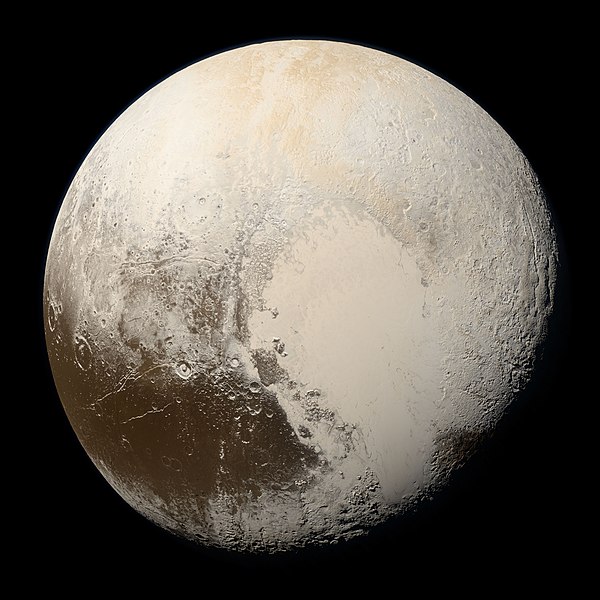
2. And this:

3. And this:
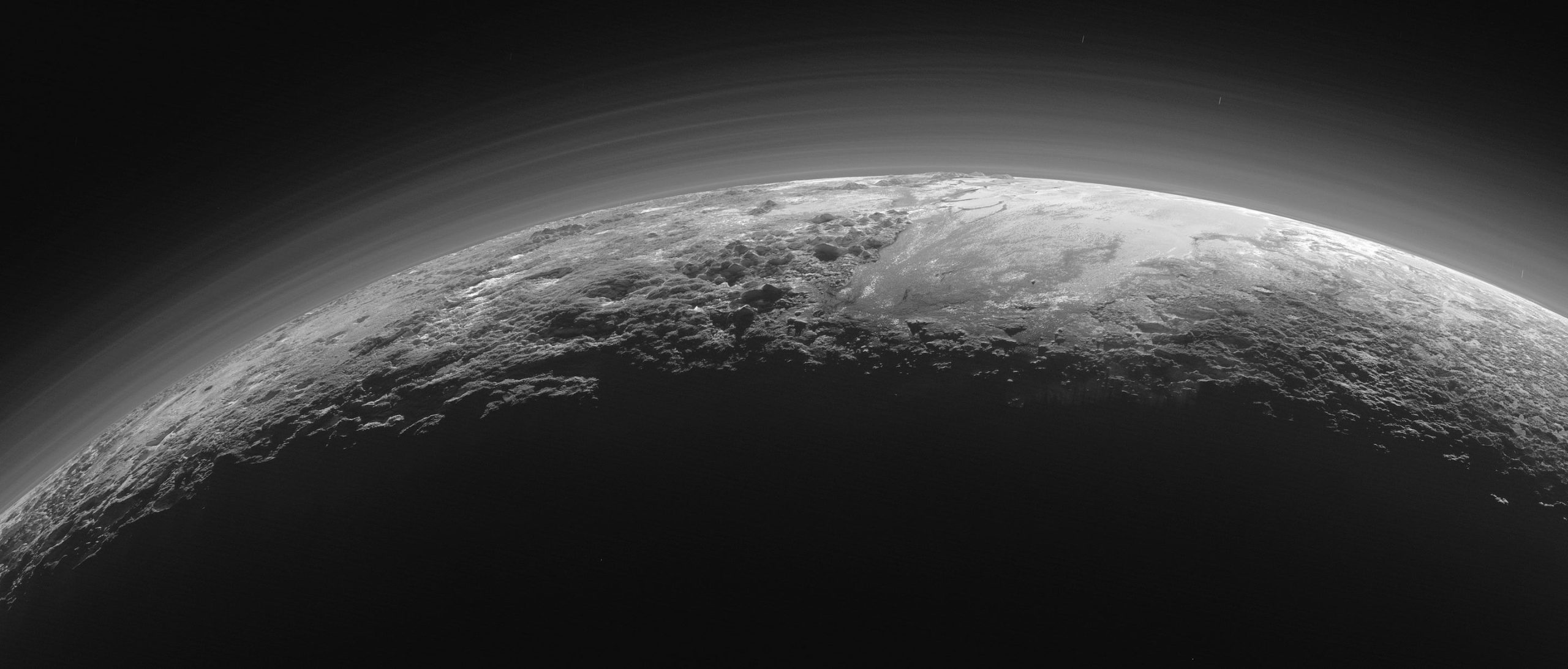
4. And this:
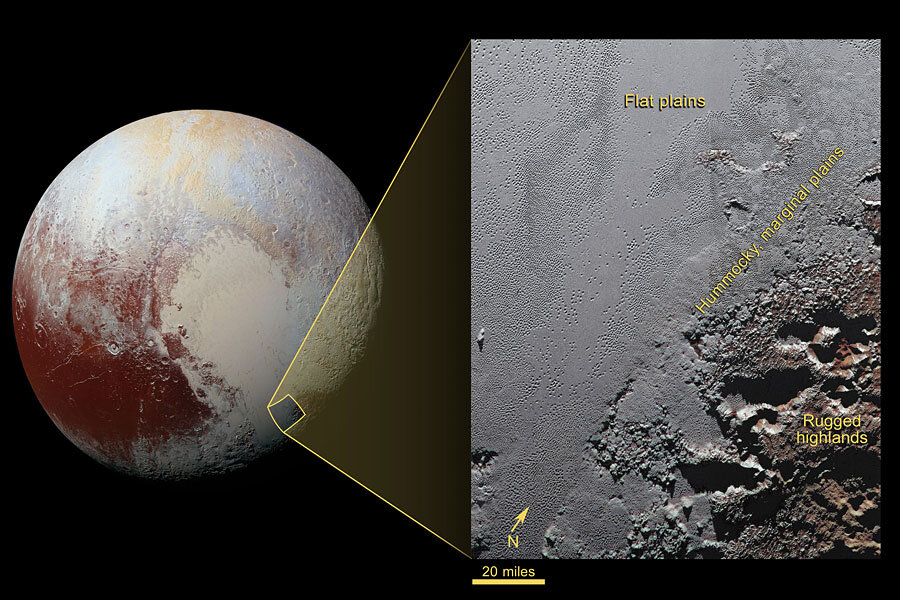
5. And this:

6. And this:
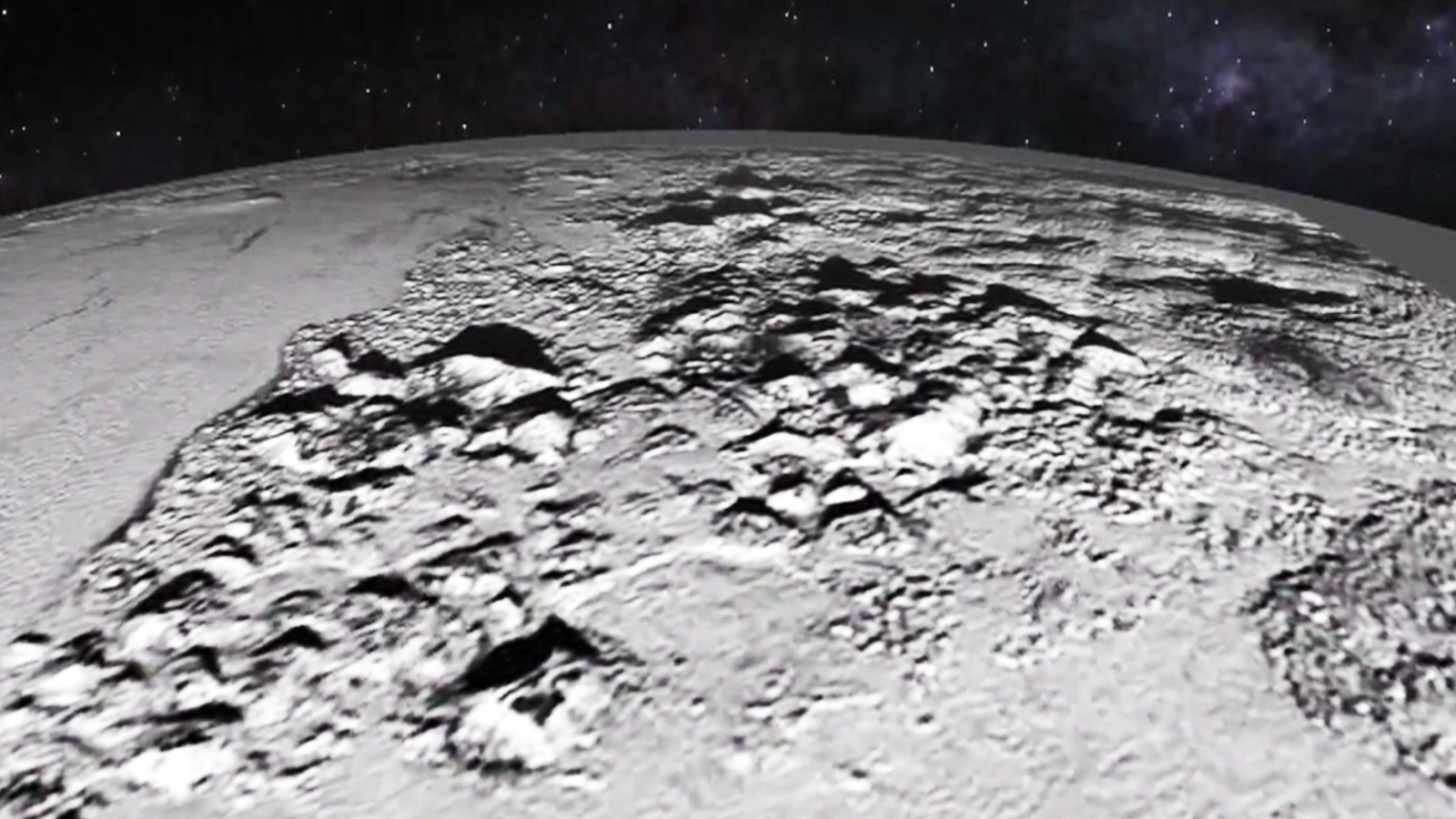
7. And this (ice volcanos highlighted in blue:
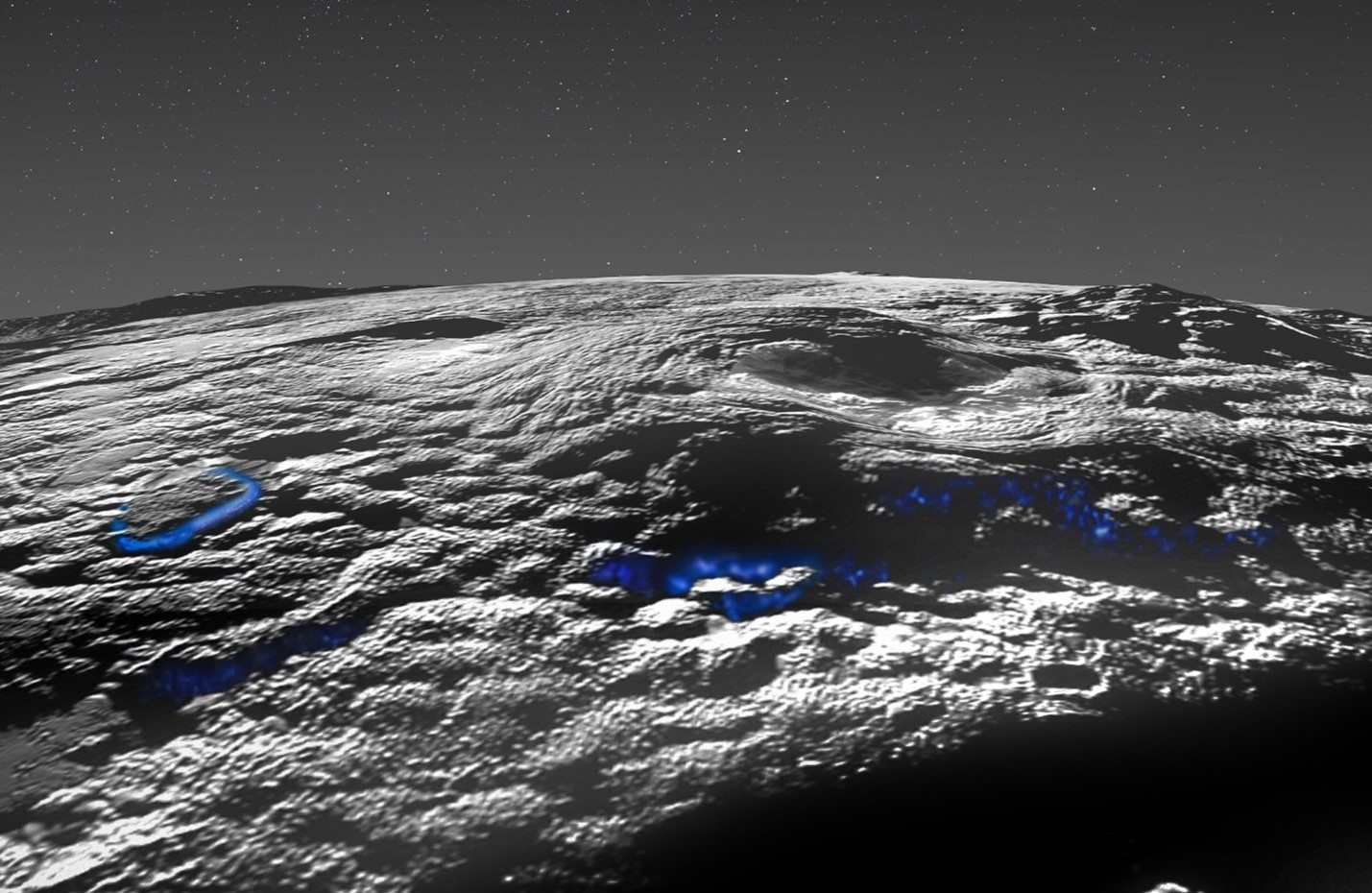
8. And finally (but not really, I could keep going on) this:
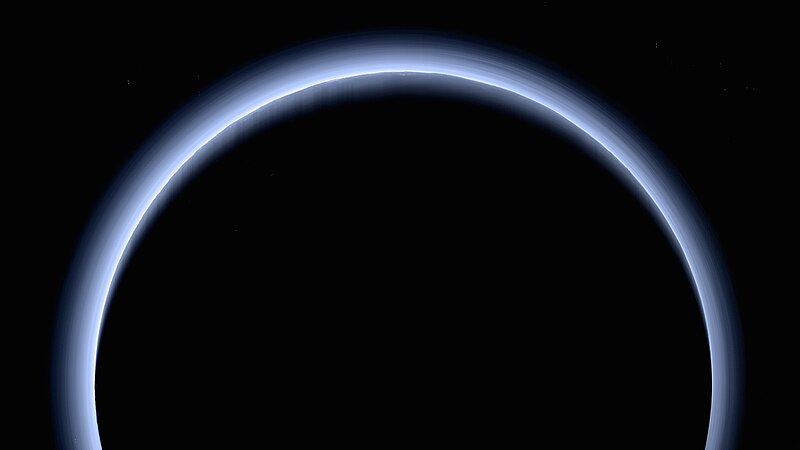
And that’s Pluto, yet more pictures and data were taken of its largest moon Charon:
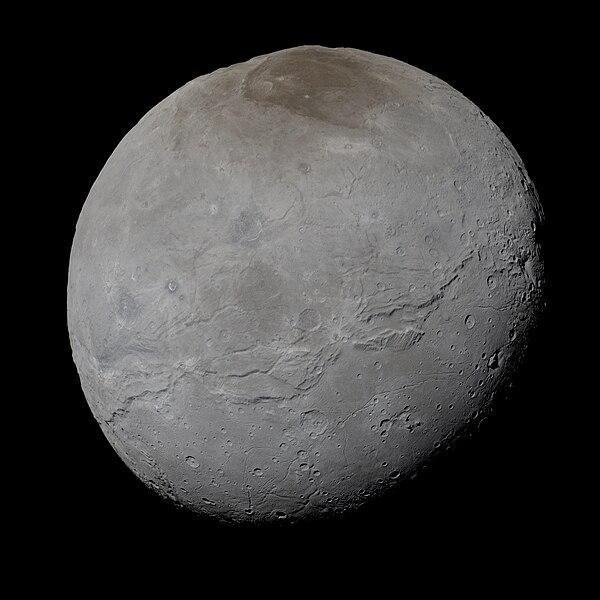
And the other four moons; it’s probably easiest to just throw a composite image at you:
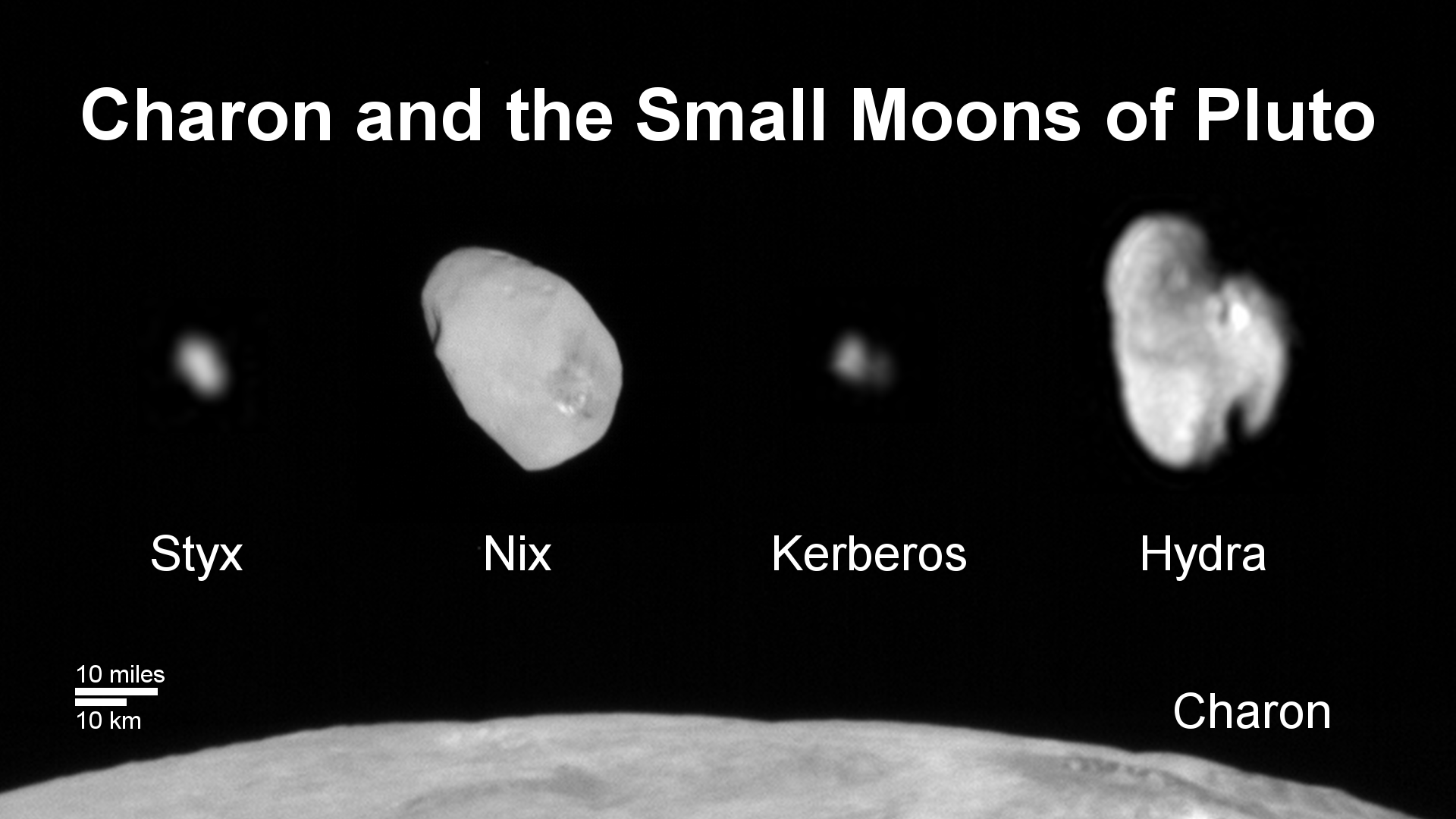
So needless to say we know a lot more about Pluto than we do about all of the other TNOs I’ve talked about, put together.
NASA does engage in CGI sometimes (in spite of the fact that the Flerfers claim it does–they’re generally completely wrong but not in this case) and they produced this video of what a flyby would look like, based on what New Horizons returned:
Pluto Itself
So…here we go.
Pluto was named after the Roman god of the Underworld, the corresponding Greek god was Hades. It’s 2,376.6 km across, give or take 1.6 km. And 0.2 percent as massive as the Earth or 17.7 percent as massive as the Moon. It orbits the Sun in 248 years, rotates once on its axis in 6.38680 days…but with an axial tilt of 122.53 degrees, it’s considered a retrograde rotation. (These numbers are awfully precise, on account of New Horizons.) At this particular time Pluto’s northern hemisphere is pointed towards the Sun, and New Horizons thus was unable to get the very southernmost part of Pluto, it was in darkness during the entire time of the encounter.
Pluto’s rotation is the same as Charon’s orbital period, which means that not only does Charon always show the same face to Pluto (as is true with every other major moon in the Solar System), but Pluto always shows the same face to Charon. Scientists will invent coordinate systems at the drop of a hat, and the line directly facing Charon is the 0 degree longitude line on any map of Pluto.
Geology and Geography
Oh, that reminds me:

Pluto has mountains and plains, and the first picture plainly shows the “Heart of Pluto” which simply had to be named Tombaugh Regio after Clyde Tombaugh. Tombaugh Regio is a plain, and by the way, is on the side of Pluto that faces away from Charon. The plains are mostly nitrogen ice (brrrr), with some methane and carbon monoxide, all in solid form of course.
The western and more distinct lobe of the “Heart” is Sputnik Planitia, a 1000 km wide basin of frozen ice, but as the second image shows it’s divided into polygonal cells, almost certainly convection cells that carry floating blocks of water ice crust and sublimation pits at the margins. There are signs of glacial flows both into and out of the basin. Furthermore, not one single crater was spotted, which indicates that Sputnik Planitia’s surface is less than ten million years old; in fact the latest work claims 140,000-270,000 years. There are also transverse dunes in Sputnik Planitia, which are formed by wind-blown particles, in this case of frozen methane.
What are the mountains made of? Water ice. When you order something “on the rocks” here, you mean it literally. The color ranges from charcoal black to dark orange and white; Pluto has as much contrast as Iapetus.
The fifth “This” above shows lots of 500 m high mountains from Tartarus Dorsa, the spacing reminds people of scales or tree bark. This doesn’t appear anywhere else we know of, except maybe on the unseen side of Triton…or perhaps in the Atacama desert. These are likely penitentes, icy spires that form in deserts, so named because they resemble large numbers of people at prayer.

Cutting through Tartarus Dorsa and Pluto’s heavily cratered northern terrain (and therefore younger than either) are a set of six canyons radiating from a single point; the longest is Sleipnir Fossa which is at least 580 km long.
And cryovolcanos. We’ve identified two possible cryovolcanos, Wright Mons and Piccard Mons. Piccard Mons is not named after Star Trek’s Jean Luc Picard but rather the French ballooning pioneer (two C’s, see?).
Pluto, in short shows an absolutely stunning variety of geology. Glaciological, surface-atmosphere (the dunes), impact (craters), tectonic, likely cryovolcanic, and mass-wasting (rocks falling down hill), it’s all there. This world turns out to be much more interesting than I expected back then.
Internal Structure
We know Pluto’s size. We know its mass. That means we know its average density; divide the mass by the volume. And we get 1.853 g/cm3. That means it’s a mix of rocks (things we think of as rocks) and ice, and it’s roughly 70/30 rock/ice. So we believe Pluto has a silicate (rock) core, surmounted by a mostly-water ice mantle and crust. It may even have a subsurface ocean like Europa and Enceladus. Though some think it may now be frozen, it’s just barely possible it was inhabited at one point. (This is one place where Wikipedia is a bit frustrating. The text makes it sound like no one believes there’s still liquid water down there, but the diagram indicates otherwise.)

Atmosphere
Pluto has an atmosphere as is quite evident in pictures 3 and 8 above. In fact getting New Horizons out there quickly rather than waiting a few more decades was partially motivated by this; Pluto is fairly close to the Sun right now, and that, we thought, would make the atmosphere more active. As Pluto got further from the Sun, its atmosphere might freeze out.
The atmosphere is made up of nitrogen, methane, and carbon monoxide, all sublimated from the surface ices, and in equilibrium with them (if any of them “snow” out of the atmosphere, then ices elsewhere on Pluto will sublimate to restore them). The pressure is anywhere from 1 millionth to 1/100,000th that of Earth.
Since New Horizons was launched, however, we’ve determined the atmosphere might actually thicken as it gets colder.
In any case, New Horizons‘s parting shot at Pluto was a backlit shot, used to image the atmosphere. Scientists have learned to take a “backlit shot” opportunity when it presents itself.
Moons
Pluto has five moons. And all of them are regular, orbiting in the plane of Pluto’s equator. Here’s a scale diagram…full scale, distances and diameters shown accurately (you rarely see those in astronomy!).

First up is Charon. Orbiting at 19,595.764 km from Pluto (give or take 7 or 8 meters!) and at 1212 km across, it’s a medium size moon according to the terminology I’ve been using, so now we have nine: Rhea, Iapetus, Dione and Tethys at Saturn, Ariel, Umbriel, Oberon and Titania at Uranus, and now Charon.
Pluto is 2376.6 km across. Compared to it Charon is huge. No, wait, yuge. It’s bigger than Ceres.
Charon was discovered in 1978, and named after the ferryman of the underworld in Greek mythology. (You had to pay him a coin to get ferried across. No word on what people who died in the Trojan war (centuries before coinage) had to do.) But that brings up a question. How do you pronounce “Charon”? The Greeks spell it Χάρων, and that X is like the ch in Bach. But no one in English-speaking countries says that, it’s either “Sharon” or “Karon.” The discoverer, James W. Christy (born 1938), maintains that he named it after both Χάρων and his wife Charlene, who was nichnamed “Char” (pronounced Shar), so he goes with “Sharon.” (I’m just insane enough I’d probably try to pronounce it with the ch in Bach if I ever had the chance to talk to someone about it. Y’all are both doing it wrong!)
Christy saw a bulge on the side of blobs taken of Pluto from the Naval observatory at Flagstaff. It would disappear and reappear regularly, indicating something in orbit about Pluto. In the image below (which is a photographic negative) there’s a bulge at the top on the left hand side, and no bulge on the right hand side. And so here’s an example of what Pluto looked like before HST looked at it.

Needless to say we have better pictures now.
A few years after Charon’s discovery, its orbit was edge on to us here on Earth and we could study the light curve and prove an object was transiting in front of Pluto, then behind it, even if we couldn’t resolve it as a separate fuzzy blob.
Charon is yuge compared to Pluto, and it’s the first case of a moon large enough that the center of gravity of the system is outside of the primary. Back before Pluto got demoted from planet status, many proposed that Pluto and Charon be considered a binary or double planet. And if Alan Stern succeeds in convincing people he was right, it might become one again.
In the following animation, you can see Pluto actually swinging around an imaginary point just outside of itself (and as seen above New Horizons confirmed this). There’s a black dot marking the barycenter, you’ll see it in front of Pluto when the moon is at the bottom of the image (the dot is apparently visible through Pluto in the animation). Note that Charon is closest to the viewer when it is at the top of the image. I was momentarily confused by this.
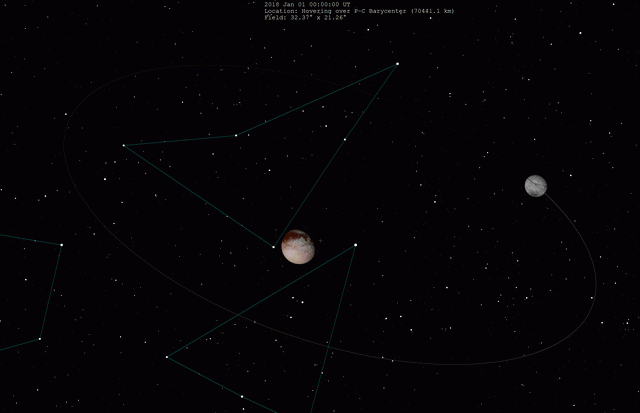
Which means that when I gave you Charon’s distance from Pluto, that was actually not the appropriate number. Its average distance from the barycenter, and thus the true size of its orbit (semimajor axis) is 17,181.0 km. It’s actually moving at a comparatively sedate 210 meters per second, and the orbit is almost perfectly circular. (The difference between the minimum and maximum distance from Pluto (not the barycenter) is a mere 6.31 kilometers.)
Charon’s density is known, 1.7 g/cm3, making it 55% rock to 45% ice (give or take 5 percent). We’re pretty sure the moon is differentiated (i.e., it has a distinct core) and may have once had a subsurface ocean. Here we have two distinct models of what Charon might look like on the inside:

…and…

And…we have a map.
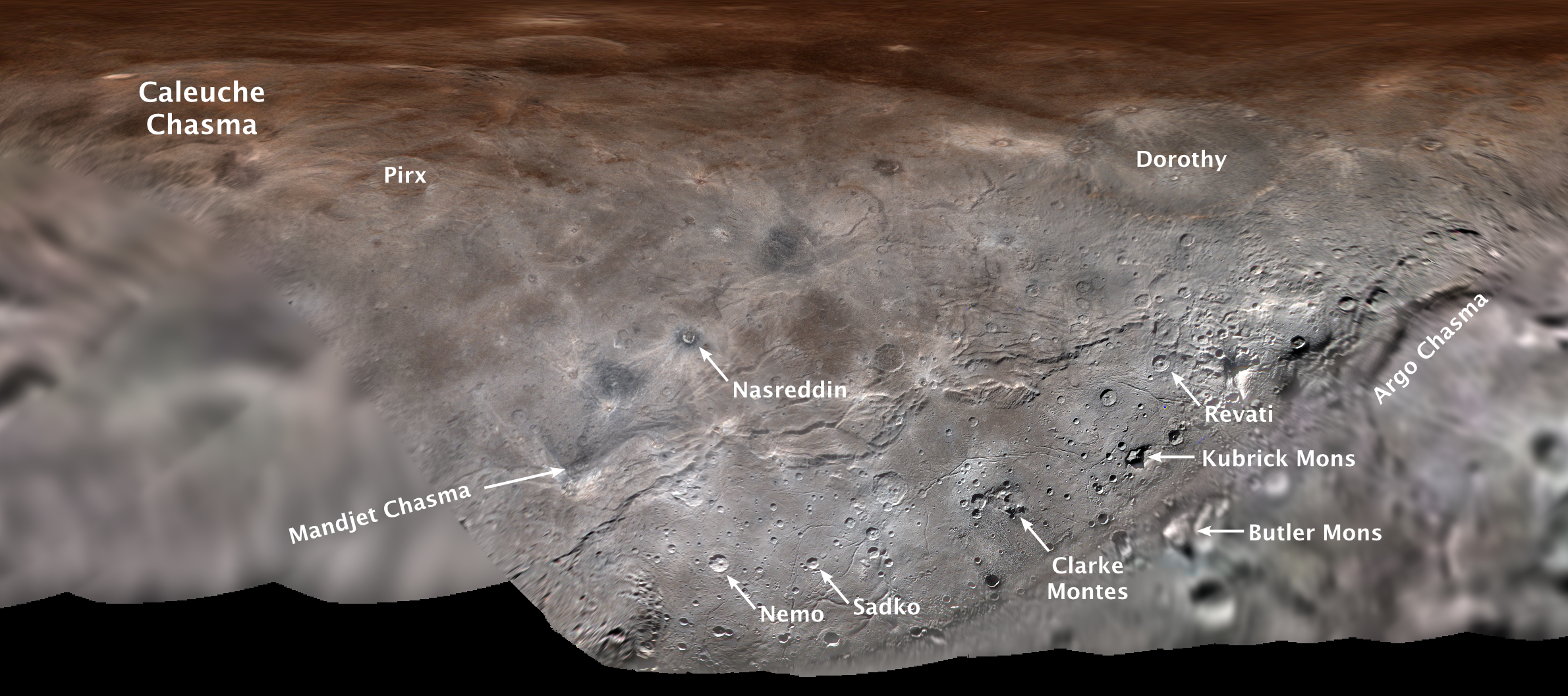
Informal names given to the various canyons included Nostromo, Serenity, Argo, and so on, named after fictional ships including recent ones like from Alien and Firefly. The northern dark area was originally named Mordor. It appears to be formed from gases that escaped Pluto’s atmosphere and blew over to Charon, carried by the solar wind. The temperature here can get as low as 15K during winter, and some tholins will form. When it gets warmer, a balmy 60K, anything that’s still an ice will boil away, leaving the pole dark.
The Other Moons
The other moons, Styx, Nix, Kerberos, and Hydra, all named after creatures and features of the Underworld in Greek mythology, all have nice tidy circular orbits in Pluto’s equatorial plane. So they’re regular moons. All are less than 51 km across. The innermost, Styx, orbits 48,694 km out…considerably further from Charon. But this makes sense. It would have to be far away from the binary object Pluto/Charon or Charon would perturb Styx’s orbit as it swept by Styx on closest approach.
One more “Moon” is Pluto itself. Since it orbits the barycenter at a distance of 2035 kilometers, which puts the barycenter outside of Pluto’s 1188 km radius, Pluto, not Charon, is actually the closest orbiting body of the whole system.
Arrokoth
New Horizons was able to visit one more object beyond Pluto (blue), shown in green.
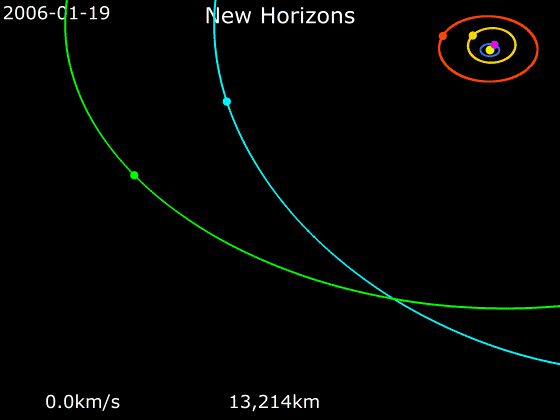
It’s 486958 Arrokoth (formerly nicknamed Ultima Thule). We didn’t know about it when New Horizons launched, but the pace of discovery of TNOs was so great we figured something would be out there we could visit with some expenditure of propellant, and Arrokoth (discovered in 2014, a bit over a year before the Pluto encounter) was chosen.
As a result, the second best known Kuiper Belt object is none of the ones I’ve mentioned so far, it’s this otherwise insignificant bit of ice and rock.
It appears to be made out of two smaller bodies, planetesimals that never became part of a planet, touching each other. The two small bodies are roughly 21 and 15 km across, for a total of 36 km along the long axis. Arrokoth orbits the Sun in 298 years. So we have our first high resolution picture of a small TNO.

We got enough data to create a geologic map:
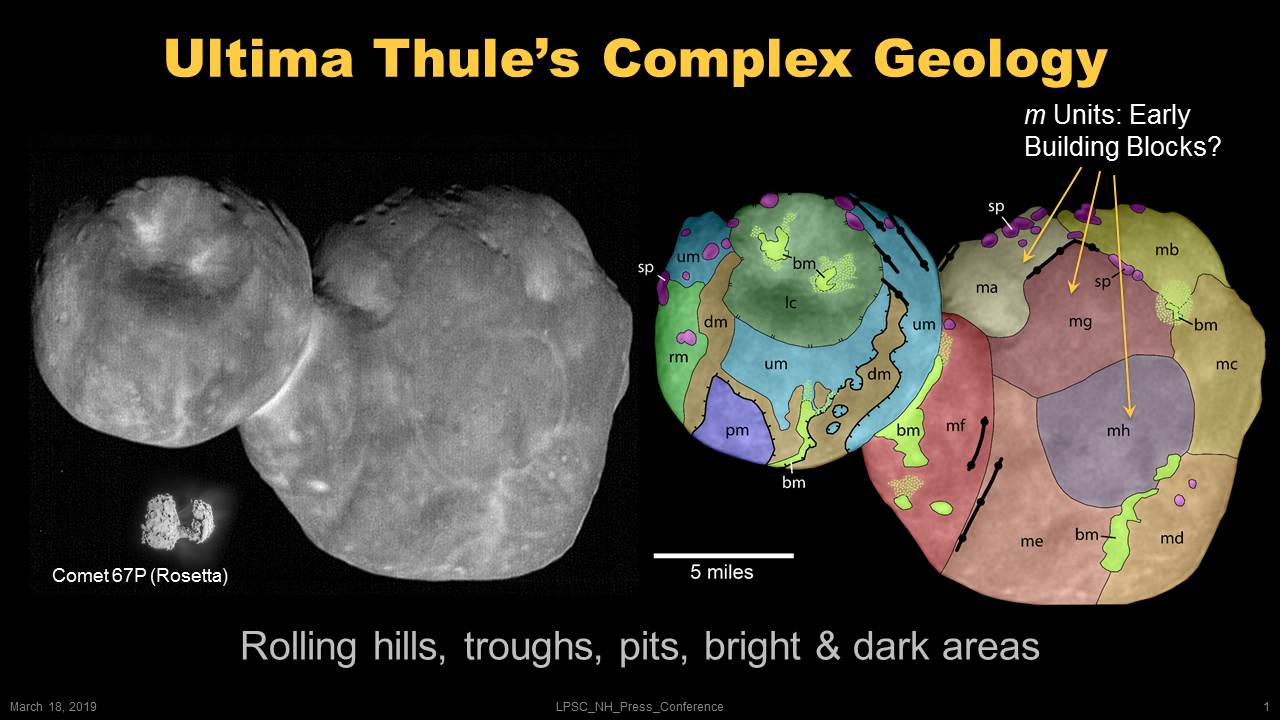
It largely consists of a mix, a solid mix of amorphous water ice and rocky material. (It is not, unlike some objects of similar size, simply a clustering of gravel that is barely stuck together.)
It’s getting late. If you want a deeper dive on this, here’s the Wiki: https://en.wikipedia.org/wiki/486958_Arrokoth
Are We Done Yet?
The Kuiper Belt. Surely we are at the outer edges of the Solar System now. Aren’t we?
Nope. And ironically we know a lot about a region we’ve never seen. Next time.






Yippee it’s Saturn’s Day.
More great stuff! This week’s science post now added to the sidebar!
I basically started working on it at about 3PM (your time) and it was continuous for the next nine hours.
I admit to being impatient to move on to the next topic. But there’s still a wee bit more I must do here.
I used to be total Astronomy Boi back when I was a kid — went to planetariums, observatories, collected books on Apollo missions, all that stuff.
After college, I let a bunch of it fade.
But with your series, I have been learning that there was a whole lot o’ shakin’ goin’ on in the ensuing years.
Mind you, I was not totally disconnected — I had known that a region of Pluto was named after Cthulhu, for instance — but I had gotten random glimpses of random programs and hadn’t seen the grand plan coming together.
Your astronomy posts have been very worthwhile on providing just such an overview.
And, as I have mentioned previously, you should be writing textbooks. They’d be a lot more informative and enjoyable than what’s currently out there.
I’d feel worse about the renaming of Cthulhu Regio if it had been a bit warmer.
Ken Paxton wants John Cornyn’s senate seat. Yippie Yi Aye! 😁
I guess we’ll get to watch Cornyn try to shed his RINO skin. Should be fun. He’s going to look real funny in MAGA cloths. I wanna see him demand Zelensky be toppled, our Billions be recouped and J6rs be released tomorrow! 😮😏😂😆
Dang it is REALLY slow tonight.
Everyone is digesting leftovers.
Well.
This is a leftist…but she actually has some common sense as far as analyzing what went “wrong” (from their point of view) this election.
I hope they continue to not listen to her.
Here’s some more “Where Dem heads are post-election 2024” — https://threadreaderapp.com/thread/1862233194143023591.html
I think it might be the brown acid. These guys did not roll their saving throws against insanity.